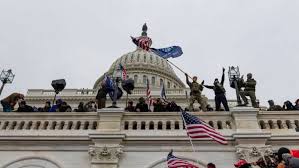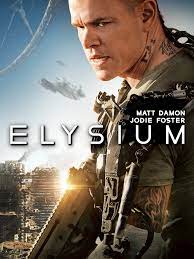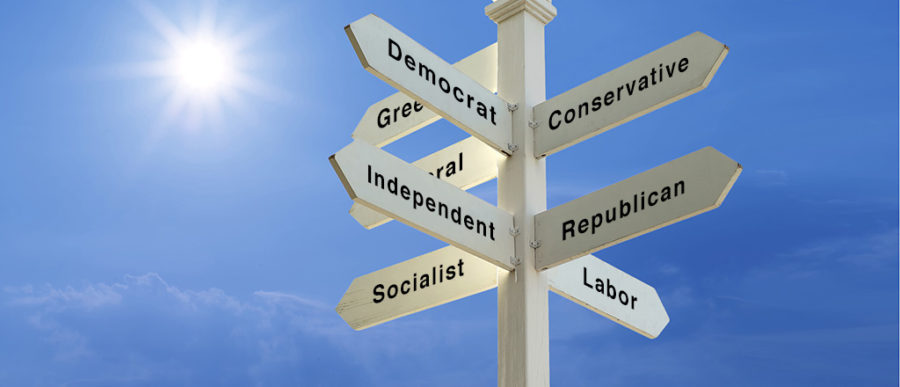
I am still flabbergasted. On Wednesday, January 6, 2021, something happened that until that day was generally considered unthinkable: a mob attempted to overthrow the government of the United States. OK, that’s not totally accurate. Technically a mob stormed the U.S. Capitol with the aim of preventing the two houses of Congress from tallying and certifying the Electoral College voting results of the November 2020 presidential election. Had this coup d’etat succeeded as planned, it would have prevented the duly elected presidential candidate from taking office on January 21.
I suspect most people know the chain of events leading up to this disaster. But for those who are not, I would summarize it as follows.
The Presidential election of November 2020 was numerically won by the challenger, Democratic candidate and former Vice President from Delaware, Joe Biden. The incumbent was New York Republican businessman,
Donald Trump. Trump had been a highly controversial president since his first day in office. Many of his political opponents have been fighting him at every turn for four years, with varying degrees of success. Many of his actions have been heavily criticized, and most of his actions as President have been overshadowed by his personal behavior. But even so, Trump has always been an interesting public figure, and he has always had an uncanny knack of generating populist support from a variety of demographics.
When he lost the election in November, he refused to accept the results. In the months leading up to the election he had been expressing concerns of voter fraud, vote tampering, and illegal manipulation of tallying equipment. When the numbers were not in his favor, he cited these issues as his reasons for rejecting the results. He and his staff mounted numerous lawsuits to have votes either rejected or recounted.
However, because of the heightened concern over voting accuracy and security, many of the states had implemented many safeguards during the election. These safeguards varied from state to state, but the overall goal was to insure that each vote was correctly and accurately counted, and that the process was well documented and recorded. So unfortunately for Trump, his lawsuits were generally thrown out by the legal system, because there wasn’t sufficient evidence to proceed.[1]
But even when the courts threw out his suits, he still refused to accept the election results. He frequently claimed it was “stolen” from him, and that there was no way we could have lost. A large part of his support base believed this as well, and held protests all around the nation. Some of these protests got rather dicey. Generally the demand was that the standing results be thrown out, recounted, or that a new election take place.
The process of electing a United States president runs from November 4 to January 6. For most of the elections I can remember, the steps that take place after the general vote are usually ignored by the general population, and viewed as simple formalities by elected officials. But this time it was different. Trump and his supporters tried to reverse the results whenever and wherever they could. So while most of the country assumed that Joe Biden would take office on January 20, there was a sizable faction that was determined to stop that from happening.
Trump himself had been pressuring some state governors to change their designated electors, with the aim of tipping the final vote on January 6. This was very evident with Georgia, where regardless of the numbers, Trump seemed absolutely certain that he had won the state, based on the size of the campaign rallies he had there. On January 3, just three days before the essential joint session of Congress, Trump spent almost an hour on the telephone with Georgia’s secretary of state Brad Raffensperger. Trump urged, begged, and even threatened Raffensperger, demanding a recount that would win Trump the state. Raffensperger flatly told President Trump that his assumptions about the voting in Georgia were wrong, that he did not have sufficient votes to win the state, and that the voting tally would stand. This was just a taste of what was to come.
Congress assembled for their joint session on January 6, with the certified electoral vote ballots in their handsome wooden boxes, to officially certify the results of the election. This is when things went haywire.
Before I continue I need to point out that the news sources I generally use are Reuters and Axios, sometimes USA Today, and occasionally the Washington Post. The AllSides media bias chart puts the first three into the “centrist” category. That is, they generally don’t lean Liberal or Conservative in their reporting.[2] The news is depressing enough as it is. I don’t need to make it worse by slogging through whatever political slant the news source may have.
Back on topic, the growing drama of the presidential election came to an explosive head on January 6, and went something like this:
10:02am, January 6: Vice President Mike Pence informs President Trump that he does not have the authority to reject the electoral vote, which Trump had been pressuring him to do. The president criticized Pence for doing this, saying on Twitter:
“Mike Pence didn’t have the courage to do what should have been done to protect our Country and our Constitution, giving States a chance to certify a corrected set of facts, not the fraudulent or inaccurate ones which they were asked to previously certify. USA demands the truth!”
Trump’s supporters echoed this sentiment.
11:00am: Trump addressed a group of several thousand of his supporters who had gathered outside of the White House, saying that Republican law makers were challenging the election results and that they would “stop the steal.”
1:10pm: Representative Paul Gosar of Arizona, objected to the acceptance of his state’s certified Electoral College votes, prompting a debate. This was expected to be the first of several such objections from Republicans in Congress.
1:47pm: The large group of pro-Trump protesters had reached the Capitol building and were attempting to gain entrance. Capitol Police had begun to evacuate some of the surrounding congressional office buildings.
2:00pm: Protesters gained entry to the Capitol building, having broken some glass and barricades in the process. Officers were seen firing pepper spray into the group in an attempt to quell or disburse it.
2:20pm: Both chambers of Congress abruptly recessed as the protesters began traveling about the building. Most members of Congress remained within the Capitol, following established shelter in place procedures.
2:40pm: Pro-Trump protesters were filmed fighting with Capitol police officers, many of whom had guns drawn.
2:50pm: Pro-Trump protesters were still fighting with police, while breaking windows and other objects. The members of Congress, still following shelter in place guidelines, donned gas masks as pepper spray began to be used within the building.
3:00pm: Protesters break into the offices of many lawmakers, including the office of Nancy Pelosi, Speaker of the House of Representatives.
3:30pm: Reports surface of one protester having been shot by Capitol police. Trump, again via Twitter, urged the mob to disperse and “go home,” while also calling them “very special.”
3:36pm:
The White House Press Secretary announced that the D.C. National Guard was en route, and that other law enforcement agencies were coming to assist as well.
4:00pm: Reports surface of an explosive device found near the Capitol. It was also reported that the device was no longer a threat.
4:10pm: Joe Biden, in a televised statement, urged the protesters to stop, stating that destroying government property and threatening the safety of elected officials is not a protest but an insurrection. He also urged them to step back and “allow the work of democracy to move forward.”
4:25pm: D.C. Police report finding at least five weapons, and confirmed 13 arrests.
5:00pm: Trump’s social media video from earlier in the day is removed. Facebook claimed that under the circumstances it was likely to generate additional violence.
5:15pm: Police used tear gas and percussion grenades to disperse the protesters.
5:30pm: District officials announce that the Capitol building was again secure, and that the mob of protesters was dispersing.
6:00pm: Many protesters remained on the streets of Washington, in defiance of an earlier announced curfew. Meanwhile, Trump posted on Twitter that events like this happen when a “sacred landslide election victory is so unceremoniously & viciously stripped away from great patriots who have been badly & unfairly treated for so long.” He ended with “Go home with love & in peace. Remember this day forever!”
6:10pm: Officials confirm that one person had died during the storming of the building, but did not provide details.
6:30pm: Twitter suspends Trump’s account, claiming that his statement from thirty minutes earlier was a violation of its public interest policies. Trump was also warned that further violations could result in the permanent closure of his account.
6:55pm: House Speaker Nancy Pelosi announced that Congress would resume proceedings of the Electoral College certification once the building was declared clear and safe by law enforcement officials.
7:59pm: Seventeen members of Congress urge Vice President Mike Pence to invoke the 25th Amendment, in response to Trump’s actions during the riot.
8:00pm: Congress resumes proceedings.
8:10pm: Senate Majority Leader Mitch McConnell announces that Congress “will not be deterred” in performing the confirmation, and that it would not be intimidated by “thugs, mobs, or threats.”
8:40pm: Some Republican lawmakers, who had planned to object to the voting results, reconsider their decision.
9:55pm: Republican Senator Josh Hawley made statements saying that we would still object to the Electoral College results, and while he objected to the violence insisted that the Senate should continue with a legal process to address his objections.
10:00pm: Officials confirmed 30 arrests.
10:15pm: The Senate voted against the Republican challenge to Arizona’s Electoral votes, 93 to 6.
11:00pm: The Associated Press confirmed four deaths during the violence in the Capitol. Both police and protesters are reported to have used pepper spray during the exchange.
3:40am, January 7: Congress certified President-elect Joe Biden’s 2020 victory.
Those are the raw facts I have found. This particular time line draws from a Washington Post article, but other sources concur with it. Subsequent news reports said that Pence, Pelosi and McConnell had all been moved to undisclosed locations during the crisis. This is certainly a good thing because it has also been suggested that members of the mob were searching for them. I suspect that had they found Pence or Pelosi, the Vice President and the Speaker would have been murdered. I’m not sure about McConnell, but I don’t think he would have had a good experience either.
Worst of all, this violence had been encouraged by none other than President Donald Trump himself. There is now talk of a second impeachment, or removing him from office using the 25th amendment. This is a mess no matter how you view it. Sadly, even after Trump leaves office, the attitudes he catered to will still be with us. Including the belief that the election had been stolen.
There are all kinds of theories floating around now. Did the mob intend to kill some of our nation’s lawmakers? I suspect they would have, if given the chance. One protester seemed to think that if they killed enough Democrats, the remaining Republicans would be enough to grant Trump a second term. Apparently many Americans have no problem with killing representatives of an opposing political party.
Some commentators have also suggested that has these protesters been largely African-American or Spanish, the Police would not have hesitated to use deadly force, and would have done so very early. This crowd has handled the way it was because it was largely White.[3]
At this writing, Donald Trump has been permanently banned from most social media platforms. The consensus is that he is likely to use them to inspire more violence, and his historical pattern supports that. He seems to thrive on conflict, especially when the conflict is about him. His narcissistic need for constant adoration thrives on such behavior.
At any rate, I don’t really know how to finish this piece, other than by posing some general questions. Could something like this happen again? Have we learned anything about ourselves? What do we have to change?
Most importantly, where do we go from here?
- Some instances of voter fraud were found, but the numbers were very small, and in no case required a recount. This actually happens with most elections in the United States, especially when older tallying methods are used. Such as hand counting paper ballots.
- The Washington Post often does have a noticeable liberal slant, so I use it with caution and generally only view if for headline briefs and regional stories.
- A better term might be European-American.
Image credit: ThePrint.in.
Chen, Shawna. “National Guard, state and federal police deployed as mob breaches U.S. Capitol.” Axios, January 6, 2021. Hyperlink.
Gardner, Amy. “I just want to find 11,780 votes: In extraordinary hour-long call, Trump pressures Georgia secretary of state to recalculate the vote in his favor.” Washington Post, January 3, 2021. Hyperlink.
Petras, George, Janet Loehrke, Ramon Padilla, Javier Zarracina and Jennifer Borresen. “Timeline: How a Trump mob stormed the US Capitol, forcing Washington into lockdown,” USA Today, January 8, 2021.Hyperlink.
“U.S. Capitol put on lockdown as pro-Trump demonstrators storm the Capitol.” Reuters, January 6, 2021. Hyperlink.
Weaver, Stephanie. “Timeline of the pro-Trump riot at the US Capitol: How the chaos unfolded.” FOX TV Digital, January 8, 2021. Hyperlink.







